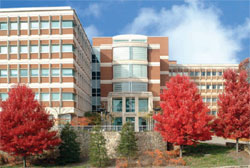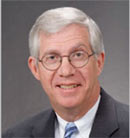University of North Carolina at Chapel Hill School of Dentistry
Chapel Hill, North Carolina
INTERVIEWEE:
John N. Williams, DMD, MBA, Professor and Dean
Question No. 1
Inside Dentistry (ID): The demographics of dental schools overall—in terms of faculty composition and the student population—are changing. What changes have you seen at your dental school in particular?
John N. Williams (JW): We have seen significant increases in minority students enrolled at our school. For example, in the class of 2004, five of our 78 admitted DDS students were African American. The numbers for the class of 2009 show that 13 out of our 81 admitted DDS students are African American. I extend much credit to the hard work and creativity of our School of Dentistry’s faculty and staff. We sponsor or are a partner in a number of efforts that bring talented minority students to our school to learn more about opportunities in the health professions. To name one, the Medical Education Development Program, which we sponsor with the UNC Chapel Hill School of Medicine, is an academically rigorous program held during the summer. Through this program, both schools seek to increase opportunities for minority students or students from underserved areas who are interested in a career in the health professions. Some of these students go on to apply for admission to our School of Dentistry, and we could not be happier about that.
We have also seen increases in our female student population, with 27 women admitted to the DDS class of 2004 and 40 women in our class of 2009. In addition, the grade point averages for science coursework that our DDS students have completed before they enter our school have been impressive: Our class of 2004 had an average of a 3.39 GPA on this coursework, and our class of 2009 had a 3.54 GPA.
Question No. 2
ID: How has your dental school responded to these changes, and what have the reactions been from students, faculty and administrators?
JW: Our faculty, staff, administrators, and students see that diversity has made a positive difference in reaching out to our state’s citizens through dental service activities in underserved areas and in the robust student clinics at the school. Diversity in our students’ background and perspective informs the life of the school in many ways and can only enhance our ability to serve our state.
On reflection—and I think quite a bit about this issue—I believe the increase in diversity within our student population places even more emphasis on the need for diversity within our faculty, who take such an active role in mentoring these students. Our most current numbers show that of the 127 permanent faculty, eight are African American, six are Latino, and 42 are female. I’ll hope to see those numbers increase in the coming years.
We are a national leader in research, with a ranking of fifth of all dental institutions nationwide in National Institute of Dental and Craniofacial Research (NIDCR) grant funding for fiscal year 2005. An increase in diversity within our faculty, combined with our faculty members’ proven excellence in research, will enable us to make an even bigger difference in research that addresses health disparities in our state and beyond.
One issue that dental schools nationwide face in recruiting faculty is the attractiveness of working in private practice. Dental school administrators—myself included—need to better articulate and demonstrate the joys and satisfaction inherent to a career within academic research and teaching.
Question No. 3
ID: There are many challenges and opportunities when it comes to oral health care. What do you see as the most urgent need, and how does your dental school differentiate itself in efforts to respond to these challenges and opportunities?
JW: The goal of the University of North Carolina at Chapel Hill School of Dentistry—the only dental school in the state—is to be useful to the citizens of North Carolina. Two challenges emerge from that mandate: We need to further encourage our graduates to provide care for underserved populations, and we need to emphasize research that improves human life.
Our School of Dentistry was one of 10 schools nationwide selected for a 5-year Robert Wood Johnson Foundation Pipeline, Profession & Practice: Community-Based Dental Education grant in 2002, and this has enabled us to significantly increase outreach to underserved communities. We offer our students many opportunities to serve the greater community, and our hope is that the rewards and education they experience will influence their career plans.
Through our outreach in communities statewide, we have seen the extraordinary needs within our state’s American Indian and Latino populations. We have directed efforts toward recruiting Latino and American Indian students—with some success. Even more efforts are necessary.
Concerning the importance of research and how it can make a difference in the lives of others, I’d like to mention our university’s Craniofacial Center as one example. Patients with cleft lip, cleft palate, and other craniofacial anomalies are treated, and ongoing research is offering great promise. Researchers at the center have received National Institutes of Health funding for more than three decades, and experts in dentistry, social work, psychology, audiology, and other fields are key collaborators in both treatment and research.
Question No. 4
ID: Exciting and innovative research initiatives are taking place at dental schools nationwide. What is the most significant area of research taking place at your dental school?
JW: I would mention two areas as among our school’s most significant research: neurosensory disorders, and oral and systemic diseases.
At the end of 2005, we celebrated a new $19 million cooperative agreement with the NIDCR that is delving into the causes and possible treatments for temporomandibular joint disorder (TMJD). Scientists at UNC Chapel Hill, the University of Florida, the University of Maryland, and the University of Buffalo, as well as Battelle Memorial Institute in Durham, NC, are collaborating on the Orofacial Pain: Prospective Evaluation and Risk Assessment (OPPERA) study. This is believed to be the first large multicenter prospective study on risk factors associated with TMJD.
Dr. William Maixner is the study’s principal investigator and will direct the new Center for Neurosensory Disorders at the School of Dentistry as a part of this effort. Through this multiyear effort, the researchers hope to unlock the door to this very common disorder that causes pain in millions of people throughout the world.
School of Dentistry researchers also are pursuing very significant research within oral and systemic diseases. I would mention, among other laudable efforts, the work of Dr. Steven Offenbacher, OraPharma distinguished professor of periodontal medicine. Dr. Offenbacher and his collaborator Dr. Jim Beck are some of the leaders of an ongoing multicenter clinical intervention addressing the possibility of a link between an expectant mother’s periodontal disease and preterm delivery.
Question No. 5
ID: What endeavors have been most successful for you in terms of securing funding for this type of research, or other types of translation research?
JW: Creativity, collaboration, careful planning, and commitment—as well as hard work—are major components to success in securing funding for dental research. I love to see the detail and collaboration apparent in a study like OPPERA (mentioned earlier), which involves researchers at UNC Chapel Hill’s schools of dentistry, medicine, and public health, as well as researchers at universities across the nation and the University of Adelaide in Australia, two NIH institutes, and other groups. Such a wide-ranging research group can really go 360 degrees around an issue under exploration.
Our School of Dentistry increased DDS student enrollment to 81 in the fall of 2003—the highest we could enroll based on space and faculty resources and still ensure a quality education for our students. So, we are planning an expanded state-of-the-art dental sciences building that would allow us to expand enrollment to 100 and also create much-needed research space. I think this building will open new vistas in terms of educational and research opportunities.
Again, I stress the importance of collaboration: Our school is nestled within a university health-science footprint that includes schools of medicine, public health, nursing, and pharmacy, as well as UNC Hospitals and the UNC Lineberger Comprehensive Cancer Center. This proximity has made collaboration on outreach and research even stronger.
Question No. 6
ID: Is there anything else you would like readers to know about your dental school, or that you would like to comment on in general?
JW: As I touched on a bit earlier, I am deeply concerned about the shortage of dental faculty nationwide and the difficulty schools are having in recruiting faculty. So many promising advances have been made in the past 10 years—innovative and exciting research, as referenced in an earlier question. Dental schools must heighten efforts to show DDS and other dental school students the richness of careers spent within the academy doing teaching and research.
An important and enjoyable part of my job is talking with our alumni, and so many of them tell me about the mentor who helped motivate them—a faculty member they especially wanted to make proud and who shaped them as professionals. This is a key part of the dental school experience, and we cannot afford to lose it. So I’m also concerned that those types of mentoring relationships so vital in the development of dental professionals are vulnerable if the nationwide shortage of faculty is not addressed.
The good news is that I believe faculty and administrators are realizing the urgency of this challenge and are making headway. Our School of Dentistry’s Clinical Research Training in Oral Diseases for Future Academicians is designed to give dentists the training they need to become independent clinical researchers who can contribute to dentistry’s rapidly expanding fields of study. Programs of that nature are a good start.
 |  | |
| University of North Carolina at Chapel Hill School of Dentistry students provide care to adults and children from North Carolina and neighboring states at the school's student clinics. Faculty and staff members supervise the students. | Tarrson Hall is the clinical teaching facility for the University of North Carolina at Chapel Hill School of Dentistry. The building houses the school's students and faculty clinics. | |
 John N. Williams, DMD, MBA John N. Williams, DMD, MBA Professor and Dean University of North Carolina at Chapel Hill School of Dentistry | ||



